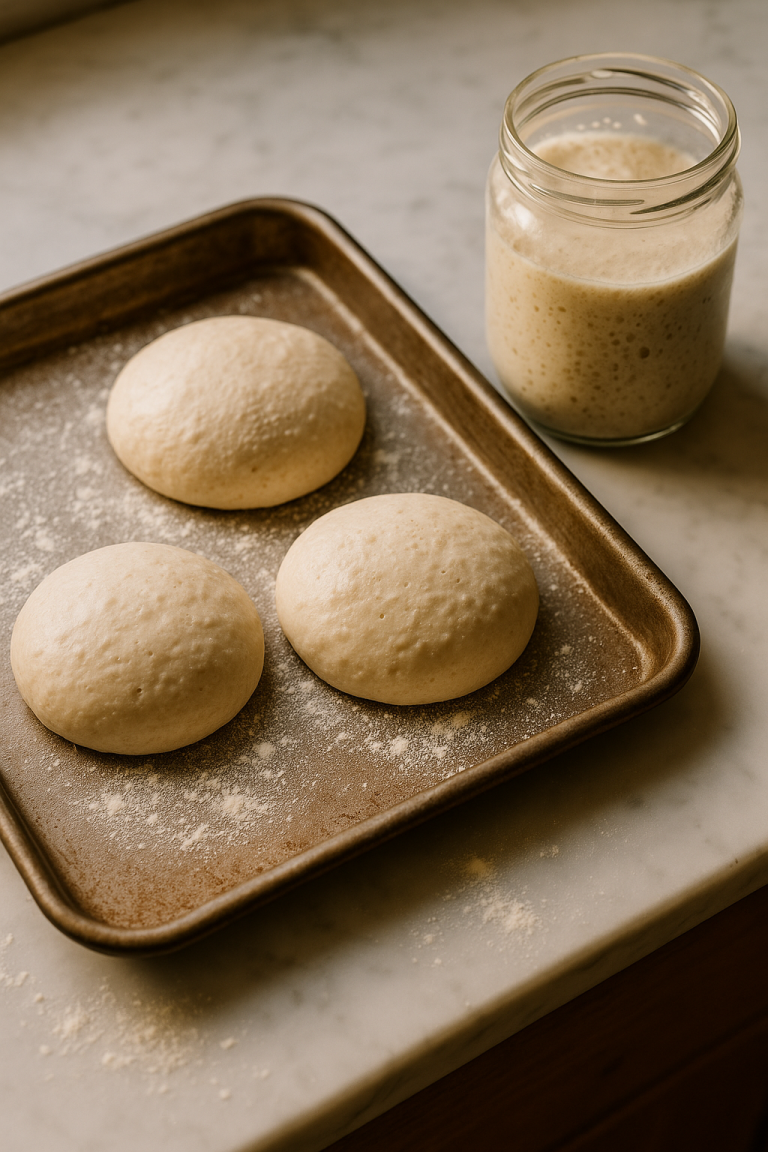Bread Crust Color Guide · What’s Too Light, Too Dark, and Just Right
After fifteen years of baking professionally and teaching home bakers, the most common question I get is: “How dark should my bread be?” Most people pull their loaves too early because they’re scared of burning. But here’s the truth—if your bread looks “pretty” when it comes out of the oven, you probably under-baked it. Real flavor lives in a dark, caramelized crust.
This guide breaks down bread crust colors from raw dough to burnt, so you know exactly what you’re looking at. Whether you’re baking sourdough, pizza, or dinner rolls, understanding crust color means better flavor, better texture, and fewer disappointing loaves. Let’s talk about what’s actually happening at each stage and why darker is almost always better.

The Bread Crust Color Spectrum
Raw (No Bake)
What it looks like: Pale, doughy, white or off-white surface. No color development.
What’s happening: Nothing. This is uncooked dough. If you’re seeing this after “baking,” your oven wasn’t hot enough or you didn’t bake long enough.
Verdict: Not bread yet. Keep baking.
Part-Baked (Severely Under-Baked)
What it looks like: Very light tan, almost blonde. Slightly dry surface but no real color.
What’s happening: Minimal Maillard reaction. The crust hasn’t developed any caramelization. The interior is likely gummy and under-cooked.
Flavor: Bland. Tastes like cooked flour with no complexity.
Texture: Soft crust that doesn’t shatter. Gummy, dense crumb inside.
When this is acceptable: Par-baking for freezing (you’ll finish baking later). Otherwise, this is a failure.
Verdict: Under-baked. You need at least 10-15 more minutes in the oven.
¾ Baked (Still Under-Baked)
What it looks like: Light golden tan, like lightly toasted white bread. Barely any color variation across the surface.
What’s happening: Early Maillard reaction starting. Some caramelization of sugars, but not enough. The crust is setting but hasn’t developed complexity.
Flavor: Mild, slightly sweet, one-dimensional. Missing the nutty, toasted notes of properly baked bread.
Texture: Soft crust that yields easily. Crumb is likely still slightly dense.
When people do this: Home bakers who are scared of “burning” their bread. They pull it because it “looks done.”
Verdict: Under-baked. This is edible but mediocre. Add 5-10 more minutes.
Light Golden Brown (Minimum Acceptable)
What it looks like: Consistent golden color, like a dinner roll or sandwich bread. Even coloring with minimal dark spots.
What’s happening: Maillard reaction is progressing. Sugars are caramelizing. Crust is fully set and beginning to develop flavor.
Flavor: Pleasant, slightly toasted, mild sweetness. This is where most commercial bread stops.
Texture: Crust has some structure but isn’t crispy. Crumb is fully cooked.
When this is appropriate:
- Sandwich bread
- Dinner rolls
- Enriched doughs (brioche, challah)
- When you want a mild, soft crust
Verdict: Acceptable for soft breads. Still too light for rustic loaves, sourdough, or pizza.
Golden Brown (Good for Most Breads)
What it looks like: Rich, warm golden brown. Like a well-toasted piece of bread. Some darker spots starting to appear, especially on edges and high points.
What’s happening: Full Maillard reaction. Sugars are deeply caramelized. Crust is developing layers of flavor—nutty, toasted, slightly sweet with hints of caramel.
Flavor: Complex. Nutty, toasted, caramelized. This is where bread starts tasting like bread instead of just cooked dough.
Texture: Crust has good structure—it shatters when you bite it. Interior is fully baked, light, and airy.
When this is ideal:
- Everyday sourdough
- French baguettes
- Country loaves
- Most artisan breads
Verdict: This is the minimum for artisan bread. It’s good, but you can go darker for more flavor.
Dark Golden Brown (Where It Gets Good)
What it looks like: Deep, rich brown like dark honey or amber. Noticeable dark spots, especially on scoring cuts (the “ears”). Surface has variation—lighter valleys, darker peaks.
What’s happening: Advanced caramelization. Crust sugars are deeply browned. Complex flavor compounds are developing—this is where you get the nutty, almost coffee-like notes in great bread.
Flavor: Rich, deep, complex. Nutty, toasted, caramelized with subtle bitterness balancing the sweetness. This is professional-level bread flavor.
Texture: Crispy, shattering crust. The contrast between crust and soft interior is dramatic. This is what you want.
When this is ideal:
- High-hydration sourdough
- Neapolitan pizza
- Rustic country loaves
- Any bread where crust flavor matters
Verdict: This is the sweet spot for artisan bread. Don’t be scared of this color—embrace it.
Dark Brown (The Professional Standard
What it looks like: Deep brown, like dark chocolate or coffee. Significant dark spotting across the surface. Scoring ears are almost black. Some people call this “too dark”—they’re wrong.
What’s happening: Maximum flavor development. Sugars are fully caramelized, bordering on slight carbonization in spots. The Maillard reaction is complete and you’re getting complex, layered flavors.
Flavor: Intense. Deeply nutty, caramelized, with pleasant bitter notes that balance sweetness. This is how bread tastes in great bakeries.
Texture: Deeply crispy, almost crackling crust. The interior contrast is extreme—thin, crisp shell around soft, airy crumb.
When this is ideal:
- Neapolitan pizza (leopard spotting)
- Pain au levain
- High-temp oven breads
- When you want maximum flavor
Is it burnt? No. Burnt means acrid, bitter, ashy flavor. This is deeply caramelized. There’s a difference.
Verdict: This is expert-level baking. If you’re hitting this color consistently, you understand bread.
Dark Baked (Pushing the Limit)
What it looks like: Very dark brown, almost black in spots. Heavy charring on high points. Most of the surface is deep brown with significant black areas.
What’s happening: You’re at the edge of caramelization turning into carbonization. Some sugars have burned. Flavor is intense but starting to tip toward bitter.
Flavor: Intensely toasted, nutty, with noticeable bitterness. Some people love this; others find it too much.
Texture: Extremely crispy, almost hard crust. Can be difficult to bite through.
When this happens:
- Wood-fired ovens (800°F+)
- Neapolitan pizza cooked fast and hot
- When you’re pushing for maximum Maillard
Is it burnt? Borderline. This is personal preference. If the flavor is still pleasant (not acrid), you’re okay.
Verdict: Advanced technique. Most home bakers should back off before hitting this level unless they’re specifically going for it.
Over-Baked / Burnt
What it looks like: Black or very dark black-brown. Heavy charring across most of the surface. Looks and smells burnt.
What’s happening: Carbonization. Sugars have burned. You’ve crossed from caramelization into actual burning.
Flavor: Acrid, bitter, ashy. Unpleasant. This is not “deeply caramelized”—this is burnt.
Texture: Hard, potentially bitter crust. Can taste like charcoal.
Verdict: You went too far. Lower your oven temp or reduce bake time.
Why Most Home Bakers Under-Bake
The problem: We’re conditioned to think golden = done. Years of sandwich bread and dinner rolls have trained us to stop at “pretty light brown.”
The reality: Artisan bread, sourdough, and pizza need to go darker. Way darker. That’s where flavor lives.
What holds people back:
- Fear of burning
- “It looks done” at golden brown
- Ovens that run cool
- Not trusting the process
The fix: Go 5-10 minutes longer than you think. If you’re scared you’re burning it, you’re probably finally baking it correctly.
How to Know When Bread Is Actually Done
Don’t rely on color alone. Use these tests:
- Internal temperature: 200-210°F for most breads
- Thump test: Tap the bottom—it should sound hollow, not dull
- Crust test: The crust should feel firm and dry, not soft
- Visual: Look for deep, rich color with darker spots on high points
At Park City’s 7,000-foot altitude: Bread can brown faster due to lower air pressure and faster moisture evaporation. Watch it closely in the final 10 minutes, but don’t pull it early just because it’s dark.
The Bottom Line
Too light: Bland, gummy, disappointing
Golden brown: Good, but not great
Dark golden to dark brown: This is where you want to be
Black and burnt: You went too far
Most home bakers need to bake their bread darker, not lighter. Stop pulling your loaves when they’re “pretty.” Let them go dark. That’s where the flavor is.
If your bread looks too dark and you’re worried it’s burnt, cut into it. Taste it. If the flavor is rich, nutty, and complex—not acrid or ashy—you nailed it. That’s the color you should be aiming for every time.






